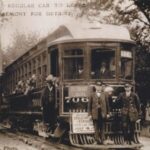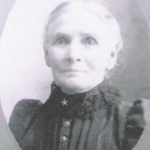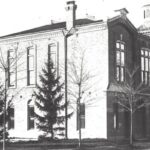On February 3, 1881, James Thomson passed away. In 1845, Mr. Thomson suggested the name “Almont” for the township and village. In 1878, he donated a clock to the village which was installed in the steeple of the First Congregational Church. In his will, Mr. Thomson left the bulk of his estate to Harper’s Hospital in Detroit, which led to the construction and operation of the hospital.
In 1859, there was not a hospital worthy of the name in the city of Detroit. Granted, there were wretched establishments where the hopelessly sick were left to die. But there was not a hospital in the modern sense.
The doctors in those days, with their small leather satchel, visited the sick using a horse and buggy for transportation. If an infectious disease was discovered, a yellow placard was nailed to the front of the door forbidding everyone from either going in or coming out. Groceries were left on the stoop by kindly neighbors and relatives.
In 1859, Walter Harper deeded over valuable real estate in Detroit and Philadelphia to establish a trust for the purpose of building a hospital and vocational school. Five years elapsed before enough money could be raised from the sale of land to consider starting construction.
The first structure was taken over by the army on a 5 year lease for its many casualties during the Civil War.
Difficult times followed for the hospital in spite of an unexpected generous gift from Walter Harper’s old housekeeper, Nancy Martin, the capital fund had shrunk to $18,578 to which was added a bequest of $5,000 from Oliver Newberry, a prosperous merchant.
In 1879, the secretary of the board of trustees, Robert W. King, had purely by chance heard of “an eccentric” farmer in Almont by the name of James Thompson, who had expressed a wish to leave his fortune of about $20,000 to some charitable institution. Mr. King wrote to Mr. Thomson and told him the problems of Harper Hospital and how strapped it was for money. Mr. King never received a reply.
Mr. Thomson passed away on February 3, 1881 and later that year the Harper board was notified that James Thomson had died and let the bulk of his estate, $11,200 to the hospital.
The Thomson bequest along with several other gifts that kept coming in was a Godsend. The old wooden barracks of Civil War days were torn down and a new brick building was constructed.
James Thomson was known throughout the Scotch Settlement and vicinity as “Poet Thomson”. He was truly a singular person in character and mode of life. He had never married and had no known relatives in this country. He came to Almont Township as a pioneer in 1833, having emigrated from his native town of Paisley, Scotland, a few years before. He settled on Section 36 south of Marr Road and lived there by himself for many years, farming and raising draft horses and cattle. He always kept bachelor’s hall and was rather noted for his untidiness of his person and the rudeness of his housekeeping.
Yet, he was a man of considerable intelligence, and though his early education was quite limited, he had read a good deal, and made some pretentions to literature. He used to bequile the tedium of his lonely evenings on the farm in his younger days by composing verses in Scotch dialect, which he would recite to his neighbors, this gaining his cognomen of “poet”. And it came to be not an unusual thing, as the settlement thickened around him, for the young people to make the rough walls of his log hut resound with their merriment in the winter evenings, while he entertained them by singing songs of which both words and music were his own. At length, when the infirmities of old age began to come on, he sold his farm to Mr. and Mrs. George Braidwood, parents of Mrs. James Anderson, moved to the village and spent the last ten years of his life there.
Another bequest of Thomson’s was the clock to the village of Almont. It was a very fine clock, but the village fathers did not wish to build a tower for it, so when it arrived it was decided to install it in the belfry of the new (1875) Congregational church a block west of the four corners. On July 29, 1878, the clock and bell were installed in the tower of the church. The windows in the tower were opened at this time.




